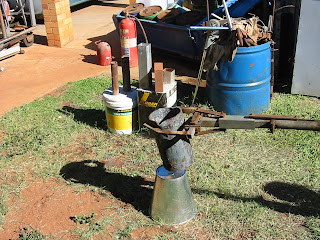The end of the pipe beam is left exposed, and open to permit the future (possible) addition of counterweights should they prove necessary, although as yet they haven't, even when the robot was used with 5L of lead used to deaden a homemade anvil.
The control for the gripper is a simple push-rod which activates through a handle located at the operator end. At the gripper end, the push rod operates a slug which is linked to the gripper bell-cranks, whereas at the operator end, the push rod is connected to a handle which can be locked at any point of it's operating range.
 In the above photo, the gripper control handle is back, towards the operator, and the grippers would be open. The arc shaped plate (quadrant) is actually the remains of a 9Kg (20lb) Propane cylinder top, left over from making a "George Vortone Muller".
In the above photo, the gripper control handle is back, towards the operator, and the grippers would be open. The arc shaped plate (quadrant) is actually the remains of a 9Kg (20lb) Propane cylinder top, left over from making a "George Vortone Muller".The quadrant has a series of cuts in the edge made with the cutoff wheel of an angle-grinder. The lever at the top of the operating handle lifts a locking bar which engages with those cuts - similar to the rachet and pawl mechanism in a handbrake.
In operation, the user grips the crucible by squeezing the lever, and then pushing the handle forward to close the gripper. Once the crucible is gripped, the lever is released and the handle stays in that position. A small amount of "spring" is in the system to permit minor positioning errors in the cuts on the quadrant.
 The above photo shows the griper control in the closed position.
The above photo shows the griper control in the closed position.The next sequence of photos shows the approach of the gripper to the crucible
 Then the nose piece locating on the tang
Then the nose piece locating on the tang and then the gripper closing on the crucible
and then the gripper closing on the crucible At this point, the crucible can be picked up, and moved through all the axes of movement the robot offers, including pouring...
At this point, the crucible can be picked up, and moved through all the axes of movement the robot offers, including pouring...
That pretty much covers the robot.. I did find one misplaced photo of the gripper mechanism without the fingers bolted on - see below. It helps clarify what I was trying to say about the mechanism being separate from the fingers and nosepiece.

The main thing this robot forces me to do is lay out my foundry area properly. I am constrained
by the centre of rotation of the robot, and the reach of the beam, and sufficient area to work in. I found these constraints allowed me to divide my work area into three distinct "zones" - HOT, WARM and COLD.
Hot is where the furnace is - pretty self evident.
Warm is for molding, pouring, degassing, skimming, etc.
and Cold is for charging, or loading the crucible.

If I pickup the crucible from the cold area, and use the robot to load it into the furnace, then I am guaranteed that it will have it's pouring lip pointed where I want it for the pour.
The robot is tall enough to permit me to place metal on top of the furnace for preheat, but I only do that when necessary - which isn't often here.
So, to sum up... The robot offers the advantage of not needing any significant lifting, in fact the heavier the crucible, then easier it is since your own body weight can be used to counterbalance the load at the gripper.
The gripper can be modified by simple bolt on fingers, and nosepiece for different crucibles, or to replace corroded parts.
The robot encourages the layout of the foundry work area into zones based on tasks, and risks
The robot can be built from scrap, and is fairly intuitive to use.
The robot permits a single operator to load, pour, reload, etc crucibles up to A30 without the use of a second person, with enough accuracy in the pour to pour water into the neck of a 2L coke bottle, and only lose 100mL (5% loss pouring into a target of 3/4" diameter at 10' away.)

No comments:
Post a Comment